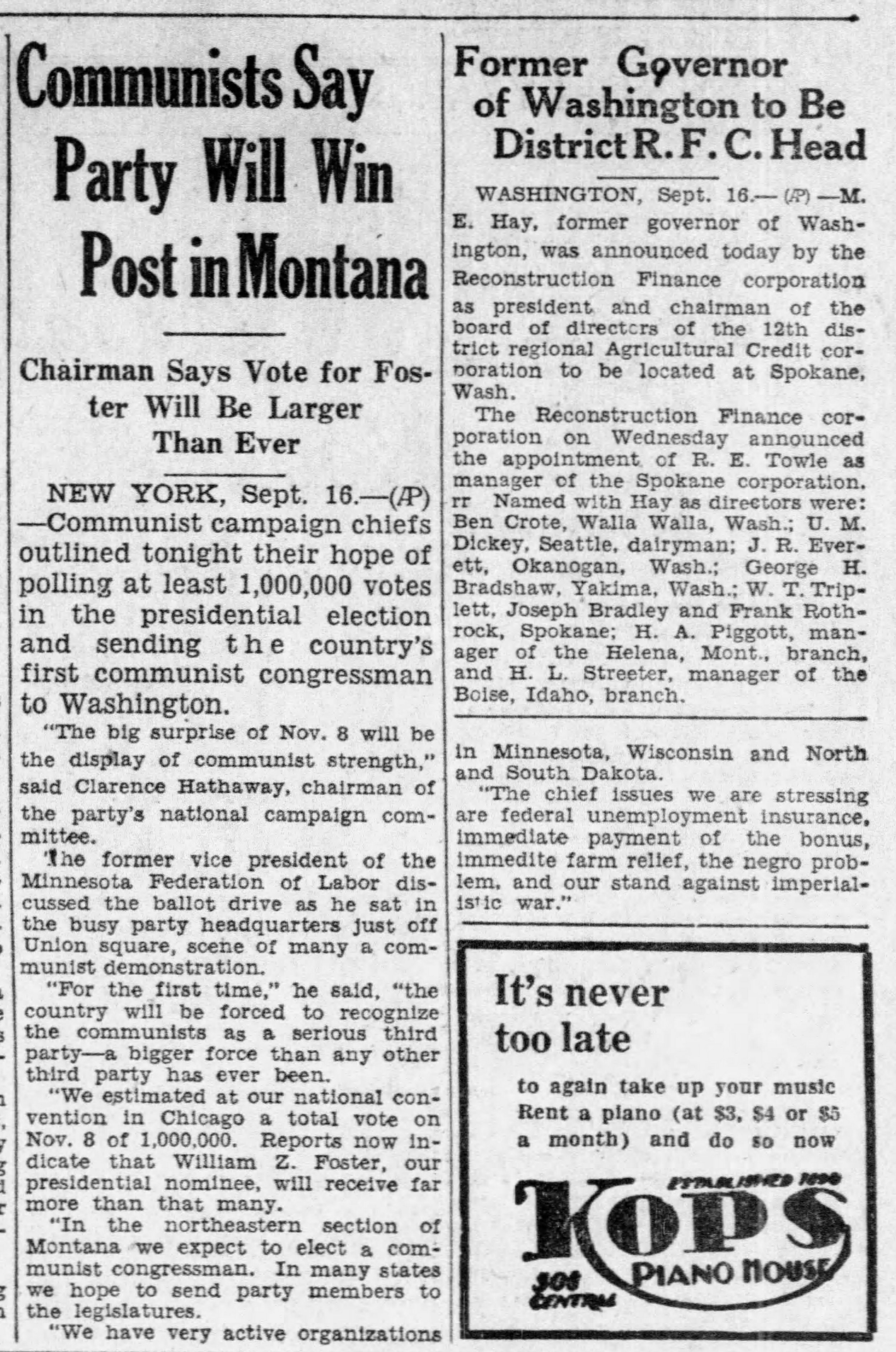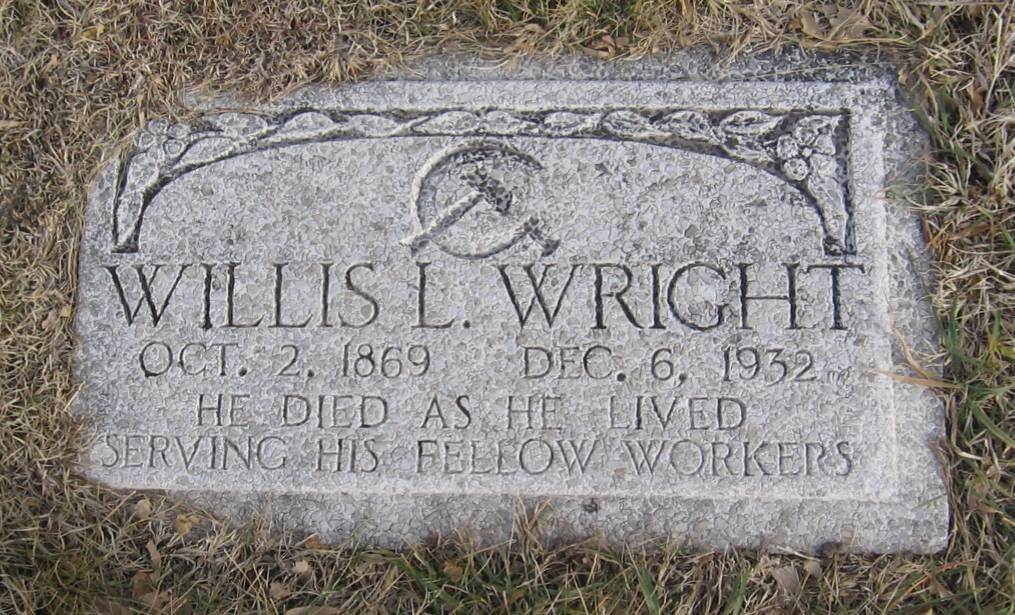A Life for the Working Class: The Cascade County Communist Party and Willis Wright
By Megan Sanford, Archives Administrator
Dr. Vernon Pedersen, Consultant
World War I was the beginning of a cascade of changes in the world triggered by the Russian Revolution, the Spanish Flu, Prohibition and ten years later, the Great Depression. As a direct result, Communism gained a foothold in the state of Montana. The Montana Communist Party was born from two different sources. In Butte, Bill Dunne, famous for staging the funeral of murdered IWW agitator Frank Little, split the Socialist Party to found the Montana Branch of the Communist Party in 1919. In Sheridan County members of the Non-Partisan League, appealing largely to farmers who were in desperate need of help, established a vigorous Party branch in Plentywood. The Montana Party’s rhetoric reached out to both halves of its constituency by promoting the slogan for “a Farmers and Workers Government.”
Willis L. Wright, Cascade County Communist Party leader
The first significant leader of the Communist Party in Cascade County was Willis Wright. Wright arrived in Great Falls in 1914. He was a carpenter by trade and became prominent in labor union circles and closely identified with local labor movements. He became a Communist shortly after the Party’s founding and kept his affiliation low key until he was publicly identified as a Party member in the 1920’s. Wright published a local newspaper called Great Falls Labor Topics, he ran for U.S. Senate on the Communist ticket in 1930, and he was chairman of the State Communist Central Committee and a district organizer, which required him to travel around Montana and into parts of Idaho.
Great Falls Tribune, Sept. 17, 1932
In 1932 the top three local branches in the Communist Party’s Montana district were Cascade County (Great Falls), Silver Bow County (Butte) and Carbon County (Red Lodge). The biggest party branch in the state was Sheridan County (Plentywood), but that branch was claimed by the North Dakota Communist Party, allegedly because of its proximity, but in reality, because of the large amount of dues Sheridan County generated. The Montana Communist Party attracted the attention of the Party headquarters in New York City and the leadership sent high-profile speakers like the Communist 1932 presidential candidate William Z. Foster, Vice Presidential Candidate James Ford, and National Committee Member of the Young Communist League Mary Himoff to speak in Great Falls. Montana had a full ticket that year with a Communist running in every national race and a majority of state and Cascade County positions as well. Among that group was Mr. Wright, who ran for the office of state legislature. The people of Montana made their choice however, and not a single Communist was elected to a county, state, or national office.
1932 Cascade County Ballot
1932 also saw the end of Willis Wright’s career as a Communist and labor organizer. Resentful of North Dakota’s claim to Sheridan County, Wright attempted to annex the Plentywood Communist Party by sending them a letter saying they were now a Party of the Montana District. The unsanctioned letter earned Wright the wrath of North Dakota District Organizer Ella Reeve “Mother” Bloor, a lifelong Socialist before becoming a founding member of the national Communist Party. Mother Bloor accused Wright of running the Cascade County Party as a private club and tolerating unorthodox ideological opinions among the members. However, it was a sex scandal involving Wright, the common law wife of a Party member, and at least two other Communists that resulted in a fight, a broken arm, and several arrests that put an end to Wright’s Party career in Montana.
Demoted from his position as state organizer, Wright was sent to Idaho as a lowly district level official. He was there when delegates from the Second National Hunger March passed through Pocatello. The Second National Hunger March was a country-wide version of hundreds of local and state level demonstrations the Communist party staged in the early years of the Depression which protested unemployment and demanded government relief. Poor roads and unreliable automobiles plagued the marchers on their trek to Washington, D.C., so Wright generously loaned them his personal vehicle. Unfortunately, Wright’s car also proved unreliable, and the marchers abandoned it in Laramie, Wyoming. Wright walked and hitchhiked to Wyoming to retrieve it, but fate had unkind plans. As he reached the eastern edge of Laramie, blowing dust and darkness obscured Wright, and he was struck by a car. His body was returned to Great Falls and buried in Highland Cemetery. His tombstone bears a hammer and sickle and the motto “He Died as He Lived Serving His Fellow Workers.”
December 6, 1932 issue of the Great Falls Leader
The Montana Communist Party lasted another 25 years before joining Willis Wright in the dustbin of history. The Party prospered under the New Deal as a fervent supporter of President Franklin Roosevelt. Bill Dunne returned to the State and got close party supporter, and possible secret Communist, Jerry O’Connell elected to the U.S. House of Representatives in 1936. During World War II support of the Soviet Union could be considered a form of patriotism and a contingent of Russian airmen took over the top floor of the Rainbow Hotel. But the beginning of the Cold War and the rigors of the Red Scare, which reached its height under Senator Joseph McCarthy, caused the Party to collapse. It survives today as a tiny, largely geriatric, remnant.
Willis L. Wright’s headstone
Interested and want to know more? See the presentation that Dr. Pedersen and Megan Sanford gave at the 2023 Montana State Historical Conference.





